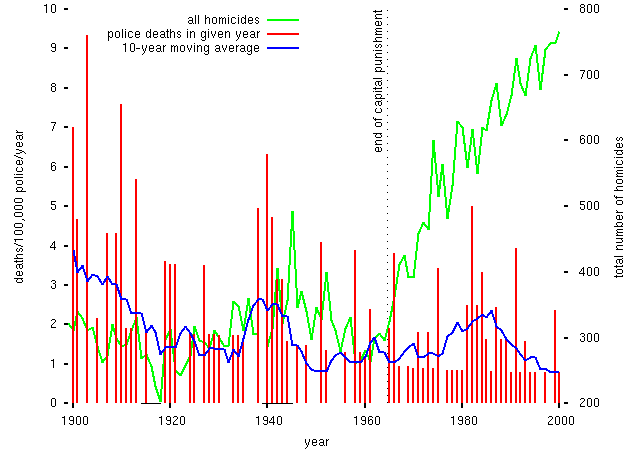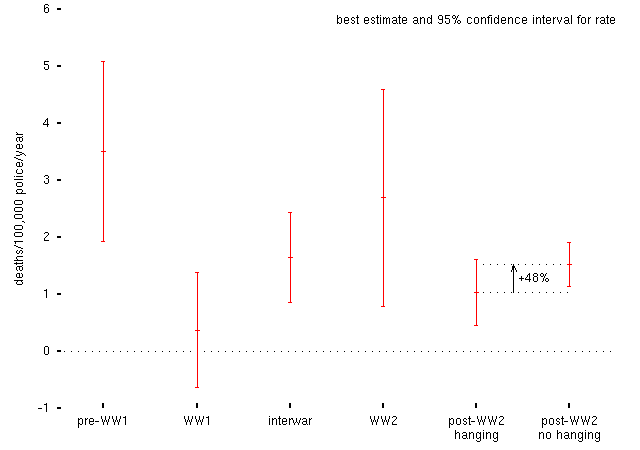Matthew draws our attention to a recent statement allegedly by a senior police officer advocating either that the police be armed routinely, or that capital punishment be reintroduced for the murder of police officers. This, of course, was provoked by the recent tragic murder of Pc Sharon Beshenivsky. Now, almost nobody is in favour of murdering police officers (the obvious exception presumably being the murderers themselves), but nor is it obvious that capital punishment is a sensible response. Matthew plots a graph of the number of police officers murdered over time, which doesn't show any very significant upward trend since capital punishment was abolished in 1964.
Here's a slightly more detailed version of the same chart, with the total number of homicides (civilian and police) also plotted: (the data here are for England and Wales only; numbers of police are drawn from this House of Commons Library paper while the number of police killed is from the Police Memorial site, excluding Scottish police and a number of English police killed by terrorists in Cyprus in 1956; and the total homicide statistics are from the Home Office):
Matthew states that the number of police killed doesn't seem to have increased sharply since capital punishment was abolished. The data fit a Poisson distribution pretty well (as you'd expect) and similarly have no serial correlation (the number of murders in year N doesn't depend on the number in year N - 1); therefore we can estimate the rate at which police are killed in any given year by generalised regression, giving something like this over different periods of the last century:
-- naively, there is an increase in rate, but the confidence intervals are pretty broad and overlap heavily (because there isn't that much data), so the estimate of the increase is pretty inaccurate. Varying assumptions make quite a big difference; the change, obviously, becomes a bit smaller (+33% rather than +48%) if we exclude the victims of domestic terrorism, or if we include the slightly more violent inter-war period in the `no hanging' data (+16%, or +5% if terrorism excluded).
(NB that none of this demonstrates an effect of the end of capital punishment, just that something coincided with it.)
But the most striking thing about this is the comparison between the risk of death for on-duty police and the overall homicide rate, which (apart from a spike during the Second World War) remained roughly constant from about 1930 until the early 1960s, and then rose sharply, approximately doubling from about 6/million/year to about 14/million/year (see, e.g., the House of Commons library paper above). In fact, the overall homicide rate is now roughly the same as the risk of death for police officers on duty.
Anyone know how much of this is down to better classification of deaths into homicide and non-homicide? Whether or not a police officer is killed on duty is a fairly unambiguous question: either they are or they aren't. That should mean that the rate of murder of police officers shouldn't be affected much by (e.g.) improvements in medical science or inquest practise. Less so for the general population, where some methods of killing (poisoning etc.) may be put down as accidental death or natural causes. So perhaps improved detection could be responsible for the difference in rates? However, I can't find any positive evidence for this (in particular, long-term data for number of homicides by method) -- any suggestions?

